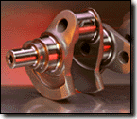
Crankshaft Grinding Information

RPM - Ron's Precision Machine, Inc.
| Engine Rebuild Kit and Parts Online Catalog |
|
Go to Import Crankshaft kits These crankshaft are machined by Topline and are not indexed but good quality. Also see Crankshaft Kits for import and domestic kits with matching bearings. Information on this page will explain what index is and it's
importance! And crankshaft installation guide. |
|
CRANKSHAFT grinding & Indexing When a crankshaft is turned to an undersize, it can and does change the stroke and degrees apart of each rod journal. To index a crank, first the machinist has to know where the stroke and degrees (swing) are. Once this is established, with the right machine to start with, the crankshaft can be indexed for both swing and stroke. Indexing is part of the blueprint process and is very important so that compression, because of deck height variation do to different stroke between rod journals, can change compression ratios between cylinders. Also swing (degrees apart between rod journals) will change the relationship between the camshaft and crankshaft. Most cranks can be indexed and still make .010 undersized journals, if the crank isn't too far off from the factory. Crankshafts that are ground to within +or- .0001 (that is one ten thousands of an inch) on rods and mains gives you a crankshaft that will give you full bearing contact with a lot longer life. If you want more strength and longevity from your engine this is a must. You may also want your crank shot-peened if for race or heavy towing. So, as a review, indexing is simply grinding all crankshaft rod journals to be all the same stroke as well as the right degrees apart. Crankshaft Installation Guide
2. CHECK CONNECTING ROD HOUSING BORES: 3. CHECK MAIN BEARING BORES: 4. CLEAN OIL PASSAGES IN CRANKSHAFT: 5. CLEAN OIL PASSAGES IN ENGINE: 6. CLEAN MAIN BEARINGS AND BORES: 7. CHECK OIL HOLE ALIGNMENT: 8. LUBRICATE BEARING SURFACES : 9. CRANKSHAFT INSTALLATION: 10. TORQUE MAIN BEARING BOLTS: 11. CONNECTING ROD INSTALLATION: 12. ROD CAP INSTALLATION: 13. CHECK PROPER END CLEARANCE: 14. PRIME ENGINE OILING SYSTEM: |
|
RPM - RON'S PRECISION MACHINE, INC. Call toll free 1-866-700-5877 to purchase parts or click Contact us anytime 24-7 or Order Form |